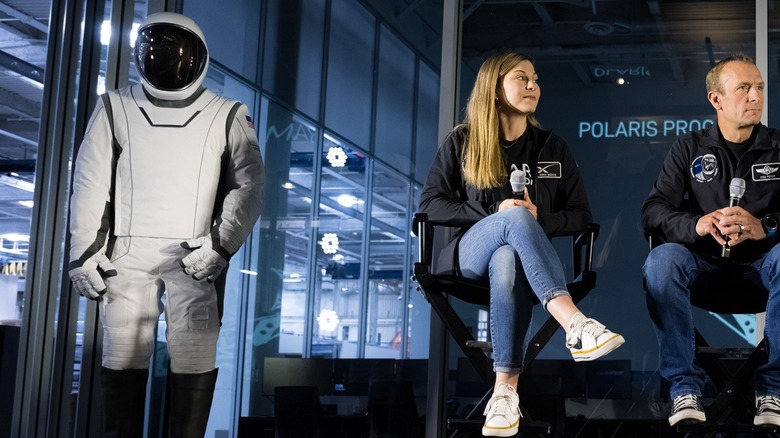Everything We Know About SpaceX's Futuristic New Space Suit
Ahead of the Polaris mission aiming to execute the first commercial spacewalk, SpaceX has revealed the next-gen spacesuit that will be at the center of it all. The company calls it the Extravehicular Activity (EVA) suit and says that its design kept in mind that astronauts need to move around easily both inside and outside the Dragon capsule. The team behind the Elon Musk-backed venture used new materials, production methods, and specially designed joints that let the suit bend and flex to allow a high degree of mobility.
The suit has been improved with enhanced reliability and the development of backup systems during spacewalks. There are extra seals and pressure valves to ensure the spacesuit stays pressurized. SpaceX claims to have created a more convenient plug-in system to attach the spacesuit to the vehicle. This plug system is home to crucial elements such as the communication kit, cooling hardware, and pressure control system.
"All of these enhancements to the EVA suit are part of a scalable design, allowing teams to produce and scale to different body types as SpaceX seeks to create greater accessibility to space for all of humanity," notes the company's website. SpaceX won't say how much each EVA spacesuit costs, but if NASA's spacesuits are any indication, the price tag comfortably goes past a million dollars.
What's special about the SpaceX EVA?
The EVA's helmet is 3D-printed and has special padding elements that house communication mics and pressure control valves. The new spacesuit comes with an upgraded visor that rotates and offers a wider field of view. The helmet also incorporates a special display screen (heads-up display) and a camera to show critical information like pressure levels inside the spacesuit, temperature levels, and humidity. Moreover, the company claims it reduces bright glare when astronauts are outside the spacecraft performing spacewalks.
The external fabric features flame-resistant materials, with Teflon fabric and Nomex playing a key role. Teflon fabrics were also a part of the spacesuits used for the Apollo missions. NASA's version of the fabric is called Beta Cloth, which is essentially ultrafine glass filament used as yarn to make fabric and then coated with Teflon (polytetrafluoroethylene or PTFE). With a melting point of over 650 degrees Centigrade, this material offered thermal shielding and protected against dangerous lunar dust for astronauts wearing the A7L space suit for the Apollo missions.
The SpaceX Extravehicular Activity (EVA) suit → https://t.co/z2Z9iVpt6x #Maythe4thBeWithYou pic.twitter.com/peETlLCcDP
— SpaceX (@SpaceX) May 4, 2024
Subsequent iterations saw NASA using new materials like Kevlar, GORE-TEX, and Nomex. Nomex, which is also used in SpaceX's EVA spacesuit, is a crucial element of firefighter suits for its flame resistance. Aside from being non-inflammable, Nomex is also a preferred choice for making spacesuits owing to its higher levels of comfort and durability. Notably, the suit Neil Armstrong wore for his historical moonwalk had both Teflon and Nomex.
Why the EVA is a key milestone
"Building a base on the Moon and a city on Mars will require millions of spacesuits. The development of this suit and the execution of the spacewalk will be important steps toward a scalable design for spacesuits on future long-duration missions as life becomes multiplanetary," says SpaceX. A spacesuit like the EVA seems ideal for space walks, but for conditions like the lunar or Martian, it would need modifications, with accounting for abrasive dust being a major one.
Now, interplanetary space travel on a crewed mission might sound like a goal a bit further into the future, but a successful spacewalk would certify the EVA's fitness as an alternative to what NASA has been doing with its own AxEMU spacesuit design candidate for the Artemiss III mission that will take astronauts to the Moon's south pole for the first time.
But spacewalks and walking on the moon are very different challenges due to the unique conditions around astronauts. If the EVA can prove its efficacy with the upcoming Polaris Dawn mission — particularly at a lower cost than what NASA spends — it's possible that the space agency could outsource suit development to SpaceX, just the way it has been using the Falcon rockets and Dragon spacecraft for its own missions. There is already some precedent for that. The AxEMU suit has been designed by SpaceX rival Axiom Space, which itself built the suit as an upgrade based on NASA's Exploration Extravehicular Mobility Unit (xEMU) prototype.

